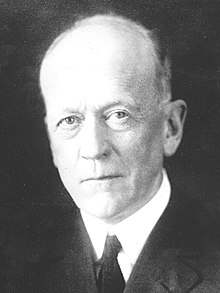Our website is made possible by displaying online advertisements to our visitors.
Please consider supporting us by disabling your ad blocker.
Charles Doolittle Walcott
Charles Doolittle Walcott | |
|---|---|
 | |
| 4th Secretary of the Smithsonian Institution | |
| In office 1907–1927 | |
| Preceded by | Samuel Pierpont Langley |
| Succeeded by | Charles Greeley Abbot |
| 3rd Director of the United States Geological Survey | |
| In office 1894–1907 | |
| Preceded by | John Wesley Powell |
| Succeeded by | George Otis Smith |
| 4th Director of the National Advisory Committee for Aeronautics | |
| In office 1920–1927 | |
| President | Calvin Coolidge |
| Preceded by | John R. Freeman |
| Succeeded by | Joseph Sweetman Ames |
| Personal details | |
| Born | March 31, 1850 New York Mills, New York, U.S. |
| Died | February 9, 1927 (aged 76) Washington, D.C., U.S. |
| Resting place | Rock Creek Cemetery Washington, D.C. |
| Spouses | Lura Ann Rust
(m. 1872; died 1876)Helena Breese Stevens
(m. 1888; died 1911) |
| Children | 4 |
| Signature | |
| Awards | Bigsby Medal (1895) Wollaston Medal (1918) Mary Clark Thompson Medal (1921) |
| Scientific career | |
| Fields | Paleontology |
| Institutions | Smithsonian Institution US Geological Survey |
| Author abbrev. (zoology) | Walcott |
Charles Doolittle Walcott (March 31, 1850 – February 9, 1927) was an American paleontologist, administrator of the Smithsonian Institution from 1907 to 1927, and director of the United States Geological Survey.[1][2] He is famous for his discovery in 1909 of well-preserved fossils, including some of the oldest soft-part imprints, in the Burgess Shale of British Columbia, Canada.
- ^ Gould, Stephen Jay (1989). "Chapter IV: Walcott's Vision and the Nature of History". Wonderful Life: The Burgess Shale and the Nature of History. New York & London: W. W. Norton & Company. pp. 240–291. ISBN 0-393-30700-X. LCCN 83-37469.
- ^ Motter, H. L., ed. (1912). "Walcott, Charles Doolittle". The International Who's Who: Who's Who in the World: a biographical dictionary of the world's most notable living men and women. New York City, U.S.A. p. 1059.
Previous Page Next Page


